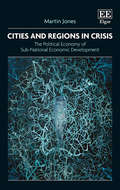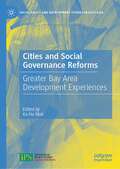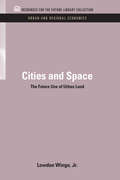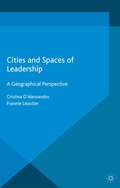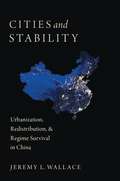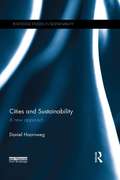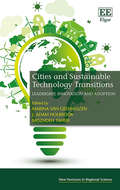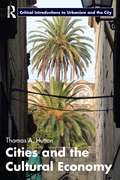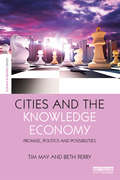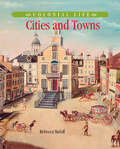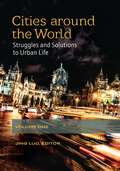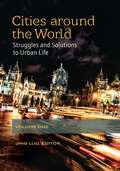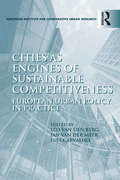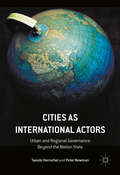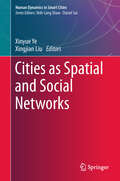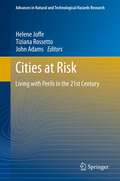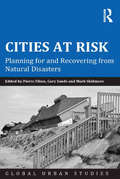- Table View
- List View
Cities and Regions in Crisis: The Political Economy of Sub-National Economic Development
by Martin JonesOffering a geographical political economy analysis, this book explores the mechanisms, institutions, and spaces of subnational economic development. Martin Jones innovatively examines how policy-makers frame problems and offer intervention solutions in different cities and regions. Drawing on different approaches to state intervention, neoliberalism, crisis and contradiction theories, and notions of depoliticisation, this book explains policy failure and how it is impacted by flux surrounding economic development. With constant changes to legislation, institutional initiatives, and ministerial responsibility, local and regional economic development is shown to be at a critical crossroads. Theoretically innovative and empirically focused, this timely book is a must-read for researchers and policy-makers of urban geography, regional development, political economy and public policy.
Cities and Social Governance Reforms: Greater Bay Area Development Experiences (Social Policy and Development Studies in East Asia)
by Ka Ho MokThis book examines critically how the Chinese government has proactively engaged the nine cities and two special administrative regions in the Greater Bay Area (GBA) in Southern China for deeper collaborations in order to transform the country from the “World Factory” to become a leading world economy in innovation and entrepreneurialism. While most of the existing research related to China’s GBA development offers the economic and technological advancement perspectives, this book focuses on critical reflections upon how the call for megacity development and deeper regional collaborations in the Bay Area will affect people’s livelihoods, social integration and urban governance. The central theme of this book builds around “Cities, Social Cohesion and Governance.” Based upon policy and document analysis, first-hand fieldwork and surveys, and intensive interviews with major stakeholders responsible for pushing the Greater Bay Area development, this book offers not only regional perspectives in analyzing the Greater Bay Area development through comparing and contrasting development experiences within the country’s different bay economies like the Shanghai and Zhejiang Bay Area and Beijing and Bohai Bay Area. The present book also draws comparative and international insights from other well- established bay economies like Tokyo Bay, Florida Bay and New York Bay Areas when analyzing the development in the GBA in China.
Cities and Space: The Future Use of Urban Land (RFF Urban and Regional Economics Set)
by Lowdon Wingo Jr.Discusses aims of urban planning and ways to achieve improved city living. Originally published in 1963
Cities and Space: The Future Use of Urban Land (RFF Urban and Regional Economics Set)
by Lowdon Wingo Jr.Discusses aims of urban planning and ways to achieve improved city living. Originally published in 1963
Cities and Spaces of Leadership: A Geographical Perspective (International Political Economy Ser. (PDF))
by Cristina D'Alessandro Frannie LéautierCities and Spaces of Leadership investigates the interaction between leadership, leaders and spaces at various levels. It analyzes how spaces and places influence leaders and leadership, as well as how the presence, distribution, action, and concentration of leaders in spaces contribute to their transformation.
Cities and Stability: Urbanization, Redistribution, and Regime Survival in China
by Jeremy WallaceChina's management of urbanization is an under-appreciated factor in the regime's longevity. The Chinese Communist Party fears "Latin Americanization" -- the emergence of highly unequal megacities with their attendant slums and social unrest. Such cities threaten the survival of nondemocratic regimes. To combat the threat, many regimes, including China's, favor cities in policymaking. Cities and Stability shows this "urban bias" to be a Faustian Bargain: cities may be stabilized for a time, but the massive in-migration from the countryside that results can generate the conditions for political upheaval. Through its hukou system of internal migration restrictions, China has avoided this dilemma, simultaneously aiding urbanites and keeping farmers in the countryside. The system helped prevent social upheaval even during the Great Recession, when tens of millions of laid-off migrant workers dispersed from coastal cities. Jeremy Wallace's powerful account forces us to rethink the relationship between cities and political stability throughout the developing world.
Cities and Stability: Urbanization, Redistribution, and Regime Survival in China
by Jeremy WallaceChina's management of urbanization is an under-appreciated factor in the regime's longevity. The Chinese Communist Party fears "Latin Americanization" -- the emergence of highly unequal megacities with their attendant slums and social unrest. Such cities threaten the survival of nondemocratic regimes. To combat the threat, many regimes, including China's, favor cities in policymaking. Cities and Stability shows this "urban bias" to be a Faustian Bargain: cities may be stabilized for a time, but the massive in-migration from the countryside that results can generate the conditions for political upheaval. Through its hukou system of internal migration restrictions, China has avoided this dilemma, simultaneously aiding urbanites and keeping farmers in the countryside. The system helped prevent social upheaval even during the Great Recession, when tens of millions of laid-off migrant workers dispersed from coastal cities. Jeremy Wallace's powerful account forces us to rethink the relationship between cities and political stability throughout the developing world.
Cities and Sustainability: A new approach (Routledge Studies in Sustainability)
by Daniel HoornwegCities are the most likely actors to design and bring about lasting sustainability. An agreement among the world’s larger cities is possible, and likely a necessary but insufficient condition to achieve sustainable development. Cities and Sustainability explores the ways in which cities are both the biggest threat to sustainability, and the most powerful tool to get us to sustainable development. Employing an innovative methodology to a complex issue, the book proposes new metrics and approaches that assume cities as fundamental in the search for sustainability. Providing population projections for the world’s larger cities and a hierarchy of sustainable cities, the author develops two new tools: (i) a cities approach to physical and socio-economic boundaries, and (ii) sustainability costs curves. These tools are designed to be implemented in a multi-stakeholder, integrated partnership that truly maximizes the benefits of cities in the quest for sustainability. Applying the tools outlined in the book to case studies from Dakar, Mumbai, Sao Paulo, Shanghai and Toronto, this volume will be of great relevance to students, scholars and practitioners with an interest in urban and city management, climate change, and environment and sustainability more broadly.
Cities and Sustainability: A new approach (Routledge Studies in Sustainability)
by Daniel HoornwegCities are the most likely actors to design and bring about lasting sustainability. An agreement among the world’s larger cities is possible, and likely a necessary but insufficient condition to achieve sustainable development. Cities and Sustainability explores the ways in which cities are both the biggest threat to sustainability, and the most powerful tool to get us to sustainable development. Employing an innovative methodology to a complex issue, the book proposes new metrics and approaches that assume cities as fundamental in the search for sustainability. Providing population projections for the world’s larger cities and a hierarchy of sustainable cities, the author develops two new tools: (i) a cities approach to physical and socio-economic boundaries, and (ii) sustainability costs curves. These tools are designed to be implemented in a multi-stakeholder, integrated partnership that truly maximizes the benefits of cities in the quest for sustainability. Applying the tools outlined in the book to case studies from Dakar, Mumbai, Sao Paulo, Shanghai and Toronto, this volume will be of great relevance to students, scholars and practitioners with an interest in urban and city management, climate change, and environment and sustainability more broadly.
Cities and Sustainable Technology Transitions: Leadership, Innovation and Adoption (New Horizons in Regional Science series)
by Marina Van Geenhuizen J. Adam Holbrook Mozhdeh TaheriCities are undoubted key players in technology creation and adoption for sustainable transitions. This book addresses both the active and passive roles of cities in technology innovation, commercialisation, mass-production and adoption. In particular, it examines elements of three socio-technical systems, energy, transport and healthcare. The authors investigate cities in Europe, Asia and North America, providing an in depth understanding of the differences in leadership roles that cities adopt across the globe. The book breaks new ground in the analysis of topical issues such as local ‘cradle’ conditions, incentive schemes, niche-development, living labs, impact bonds, grass-roots intermediation and adaptive policy making. Researchers and students involved in the urban studies, socio-technical transitions and sustainability would greatly benefit from reading this book. The variety of practical examples also makes this book an important tool for city policy makers, as well as public policy and public sector scholars.
Cities and the Cultural Economy (Routledge Critical Introductions to Urbanism and the City)
by Thomas A. HuttonThe cultural economy forms a leading trajectory of urban development, and has emerged as a key facet of globalizing cities. Cultural industries include new media, digital arts, music and film, and the design industries and professions, as well as allied consumption and spectacle in the city. The cultural economy now represents the third-largest sector in many metropolitan cities of the West including London, Berlin, New York, San Francisco, and Melbourne, and is increasingly influential in the development of East Asian cities (Tokyo, Shanghai, Hong Kong and Singapore), as well as the mega-cities of the Global South (e.g. Mumbai, Capetown, and São Paulo). Cities and the Cultural Economy provides a critical integration of the burgeoning research and policy literatures in one of the most prominent sub-fields of contemporary urban studies. Policies for cultural economy are increasingly evident within planning, development and place-marketing programs, requiring large resource commitments, but producing – on the evidence – highly uneven results. Accordingly the volume includes a critical review of how the new cultural economy is reshaping urban labour, housing and property markets, contributing to gentrification and to ‘precarious employment’ formation, as well as to broadly favorable outcomes, such as community regeneration and urban vitality. The volume acknowledges the important growth dynamics and sustainability of key creative industries. Written primarily as a text for upper-level undergraduate and Masters students in urban, economic and social geography; sociology; cultural studies; and planning, this provocative and compelling text will also be of interest to those studying urban land economics, architecture, landscape architecture and the built environment.
Cities and the Cultural Economy (Routledge Critical Introductions to Urbanism and the City)
by Thomas A. HuttonThe cultural economy forms a leading trajectory of urban development, and has emerged as a key facet of globalizing cities. Cultural industries include new media, digital arts, music and film, and the design industries and professions, as well as allied consumption and spectacle in the city. The cultural economy now represents the third-largest sector in many metropolitan cities of the West including London, Berlin, New York, San Francisco, and Melbourne, and is increasingly influential in the development of East Asian cities (Tokyo, Shanghai, Hong Kong and Singapore), as well as the mega-cities of the Global South (e.g. Mumbai, Capetown, and São Paulo). Cities and the Cultural Economy provides a critical integration of the burgeoning research and policy literatures in one of the most prominent sub-fields of contemporary urban studies. Policies for cultural economy are increasingly evident within planning, development and place-marketing programs, requiring large resource commitments, but producing – on the evidence – highly uneven results. Accordingly the volume includes a critical review of how the new cultural economy is reshaping urban labour, housing and property markets, contributing to gentrification and to ‘precarious employment’ formation, as well as to broadly favorable outcomes, such as community regeneration and urban vitality. The volume acknowledges the important growth dynamics and sustainability of key creative industries. Written primarily as a text for upper-level undergraduate and Masters students in urban, economic and social geography; sociology; cultural studies; and planning, this provocative and compelling text will also be of interest to those studying urban land economics, architecture, landscape architecture and the built environment.
Cities and the Knowledge Economy: Promise, Politics and Possibilities (The Earthscan Science in Society Series)
by Tim May Beth PerryCities and the Knowledge Economy is an in-depth, interdisciplinary, international and comparative examination of the relationship between knowledge and urban development in the contemporary era. Through the lenses of promise, politics and possibility, it examines how the knowledge economy has arisen, how different cities have sought to realise its potential, how universities play a role in its realisation and, overall, what this reveals about the relationship between politics, capitalism, space, place and knowledge in cities. The book argues that the 21st century city has been predicated on particular circuits of knowledge that constitute expertise as residing in elite and professional epistemic communities. In contrast, alternative conceptions of the knowledge society are founded on assumptions which take analysis, deliberation, democracy and the role of the citizen and communities of practice seriously. Drawing on a range of examples from cities around the world, the book reflects on these possibilities and asks what roles the practice of ‘active intermediation’, the university and a critical and engaged social scientific practice can all play in this process. The book is aimed at researchers and students from different disciplines – geography, politics, sociology, business studies, economics and planning – with interests in contemporary urbanism and the role of knowledge in understanding development, as well as urban policymakers, politicians and practitioners who are concerned with the future of our cities and seek to create coalitions of different communities oriented towards more just and sustainable futures.
Cities and the Knowledge Economy: Promise, Politics and Possibilities (The Earthscan Science in Society Series)
by Tim May Beth PerryCities and the Knowledge Economy is an in-depth, interdisciplinary, international and comparative examination of the relationship between knowledge and urban development in the contemporary era. Through the lenses of promise, politics and possibility, it examines how the knowledge economy has arisen, how different cities have sought to realise its potential, how universities play a role in its realisation and, overall, what this reveals about the relationship between politics, capitalism, space, place and knowledge in cities. The book argues that the 21st century city has been predicated on particular circuits of knowledge that constitute expertise as residing in elite and professional epistemic communities. In contrast, alternative conceptions of the knowledge society are founded on assumptions which take analysis, deliberation, democracy and the role of the citizen and communities of practice seriously. Drawing on a range of examples from cities around the world, the book reflects on these possibilities and asks what roles the practice of ‘active intermediation’, the university and a critical and engaged social scientific practice can all play in this process. The book is aimed at researchers and students from different disciplines – geography, politics, sociology, business studies, economics and planning – with interests in contemporary urbanism and the role of knowledge in understanding development, as well as urban policymakers, politicians and practitioners who are concerned with the future of our cities and seek to create coalitions of different communities oriented towards more just and sustainable futures.
Cities and Towns
by Rebecca StefoffFirst Published in 2015. Routledge is an imprint of Taylor & Francis, an Informa company.
Cities and Towns
by Rebecca StefoffFirst Published in 2015. Routledge is an imprint of Taylor & Francis, an Informa company.
Cities around the World [2 volumes]: Struggles and Solutions to Urban Life [2 volumes]
by Jing LuoThis two-volume set offers a comprehensive overview of major challenges faced by cities worldwide in the 21st century, and how cities in different geographic, economic, and political conditions are finding solutions to them.This two-volume encyclopedia examines ten critical issues that face cities across the globe today—environmental and societal struggles that affect the daily lives of city dwellers. Readers will gain a better understanding of our global neighbors and will be able to use this book in order to compare and contrast different approaches to critical issues in our world. Volume One examines employment and jobs; energy and sustainability; green spaces; housing and infrastructure; and migration and demographic changes. Volume Two discusses pollution; schools; traffic and transportation; violence, corruption, and organized crime; and waste management. Each issue begins with an introduction providing an overview of the issue from a global perspective. Following the introduction are ten alphabetically arranged world city profiles of cities that are struggling with the issue and cities that have found innovative solutions to deal with the crisis. The profiles explain how the problem came to be; consequences inhabitants face, such as compromised health, limited access to education, and high taxes with low wages; and failed and successful initiatives taken by city management.
Cities around the World [2 volumes]: Struggles and Solutions to Urban Life [2 volumes]
This two-volume set offers a comprehensive overview of major challenges faced by cities worldwide in the 21st century, and how cities in different geographic, economic, and political conditions are finding solutions to them.This two-volume encyclopedia examines ten critical issues that face cities across the globe today—environmental and societal struggles that affect the daily lives of city dwellers. Readers will gain a better understanding of our global neighbors and will be able to use this book in order to compare and contrast different approaches to critical issues in our world. Volume One examines employment and jobs; energy and sustainability; green spaces; housing and infrastructure; and migration and demographic changes. Volume Two discusses pollution; schools; traffic and transportation; violence, corruption, and organized crime; and waste management. Each issue begins with an introduction providing an overview of the issue from a global perspective. Following the introduction are ten alphabetically arranged world city profiles of cities that are struggling with the issue and cities that have found innovative solutions to deal with the crisis. The profiles explain how the problem came to be; consequences inhabitants face, such as compromised health, limited access to education, and high taxes with low wages; and failed and successful initiatives taken by city management.
Cities as Engines of Sustainable Competitiveness: European Urban Policy in Practice
by Leo van Berg Jan van MeerReflecting on two decades of ’competitiveness-oriented’ urban policies in Europe, this book investigates the current challenges cities face to sustain their economic position and how this can be balanced with social progress and environmental improvements. Complementing previous surveys on local and urban development and competitiveness-based strategies, this volume provides longer term views on the evolution of such policies at the city level, from the personal perspective of city officials in eight European cities. More concretely, it looks at how the urban dimension in EU policies have evolved over time, the kinds of urban policy supported by the EU over the last two decades and how cities have been involved with this process. The book investigates the portfolios of competitiveness-oriented policies which have been developed by European cities and how they see the link between urban/spatial development policies and sustainable competitiveness. Finally the book fleshes out a number of challenges and initiatives taken by the eight European cities and their governments in the face of current challenges in order to pave the way towards more competitive and sustainable urban economies.
Cities as Engines of Sustainable Competitiveness: European Urban Policy in Practice (Euricur Ser. (european Institute For Comparative Urban Research) Ser.)
by Leo van Berg Jan van MeerReflecting on two decades of ’competitiveness-oriented’ urban policies in Europe, this book investigates the current challenges cities face to sustain their economic position and how this can be balanced with social progress and environmental improvements. Complementing previous surveys on local and urban development and competitiveness-based strategies, this volume provides longer term views on the evolution of such policies at the city level, from the personal perspective of city officials in eight European cities. More concretely, it looks at how the urban dimension in EU policies have evolved over time, the kinds of urban policy supported by the EU over the last two decades and how cities have been involved with this process. The book investigates the portfolios of competitiveness-oriented policies which have been developed by European cities and how they see the link between urban/spatial development policies and sustainable competitiveness. Finally the book fleshes out a number of challenges and initiatives taken by the eight European cities and their governments in the face of current challenges in order to pave the way towards more competitive and sustainable urban economies.
Cities as International Actors: Urban and Regional Governance Beyond the Nation State
by Peter Newman Tassilo HerrschelThis book explores the growing role of cities and regions as sub-national actors in shaping global governance. Far from being merely carried along by global forces, cities have become active players in making and maintaining the networks and connections that give shape to contemporary globalization. Exploring examples from Europe, North America and beyond, the authors reconcile the two separate, yet complimentary, theoretical and analytical lenses adopted by Urban Studies and International Relations, as they address the nature of ‘cities’ and ‘internationality’. The authors challenge academic debate that is reluctant to cross disciplinary boundaries and thus offer more relevant answers to the new phenomenon of international city action, and how it weakens the traditional prerogative of the state as primary actor in the international realm. Conclusions focus on how this new internationality opens opportunities for cities and regions but also contains potential pitfalls that can constrain policy options and challenge the legitimacy of policy making at all scales.
Cities as Spatial and Social Networks (Human Dynamics in Smart Cities)
by Xinyue Ye Xingjian LiuThis book reports on the latest, cutting-edge scholarship on integrating social network and spatial analyses in the built environment. It sheds light on conceptualization and Implementation of such integration, integration for intra-city level analysis, as well as integration for inter-city level analysis. It explores the use of new data sources concerning human and urban dynamics and provides a discussion of how social network and spatial analyses could be synthesized for a more nuanced understanding of the built environment. As such this book will be a valuable resource for scholars focusing on city-related networks in a number of ‘urban’ disciplines, including but not limited to urban geography, urban informatics, urban planning, urban sociology, and urban studies.
Cities at Risk: Living with Perils in the 21st Century (Advances in Natural and Technological Hazards Research #33)
by Helene Joffe, Tiziana Rossetto and John AdamsWith the major growth of the world’s population over the past century, as well as rapid urbanisation, people increasingly live in crowded cities. This trend is often accompanied by proliferation of poorly built housing, uncontrolled use of land, occupation of unsafe environments and overstretched services. When a natural hazard strikes such a city many people are vulnerable to loss of life and property. This book explores what these people think and feel about the threats that they face. How do they live with perils ranging from earthquakes to monsoons, from floods to hurricanes, in the 21st century?The authors are drawn from a large range of disciplines: Psychology, Engineering, Geography, Anthropology and Urban Planning. They also reflect on how perils are represented in multiple cultures: the United States, Japan, Turkey, Bangladesh, the United Kingdom and New Zealand. The book therefore not only brings to light the ways that different cultures represent natural hazards but also the different ways in which various disciplines write about living with perils in the 21st century.The book is addressed both to researchers and to organizations involved with risk management and risk mitigation.
Cities at Risk: Planning for and Recovering from Natural Disasters (Global Urban Studies)
by Gary Sands Pierre FilionAs levels of urbanization increase around the world, the growing concentrations of population and economic activity increases vulnerability to natural disasters. Interdependencies among urban populations mean that damage to the built environment, including water, sewer and energy infrastructure, can affect millions. Even if there is no change in the rate of occurrence of natural disasters (an unlikely prospect in the face of ongoing climate change) the potential for human and economic loss will continue to increase, along with the time required to recover. How do cities prepare for and recover from natural disasters? In this book, the authors provide a broad overview of the issues related to the impacts of disasters on cities around the world, from assessing risks to accounting for damages. The comparative approach across different types of disasters in a range of urban locations is useful in identifying opportunities for policy transfer. While there is no ’one size fits all’ solution to hazard mitigation, valuable lessons can be learned from the experiences of others. The chapters emphasize different modes for assessing hazard risk, as well as strategies for increasing the resiliency of vulnerable populations.
Cities at Risk: Planning for and Recovering from Natural Disasters (Global Urban Studies)
by Gary Sands Pierre FilionAs levels of urbanization increase around the world, the growing concentrations of population and economic activity increases vulnerability to natural disasters. Interdependencies among urban populations mean that damage to the built environment, including water, sewer and energy infrastructure, can affect millions. Even if there is no change in the rate of occurrence of natural disasters (an unlikely prospect in the face of ongoing climate change) the potential for human and economic loss will continue to increase, along with the time required to recover. How do cities prepare for and recover from natural disasters? In this book, the authors provide a broad overview of the issues related to the impacts of disasters on cities around the world, from assessing risks to accounting for damages. The comparative approach across different types of disasters in a range of urban locations is useful in identifying opportunities for policy transfer. While there is no ’one size fits all’ solution to hazard mitigation, valuable lessons can be learned from the experiences of others. The chapters emphasize different modes for assessing hazard risk, as well as strategies for increasing the resiliency of vulnerable populations.
